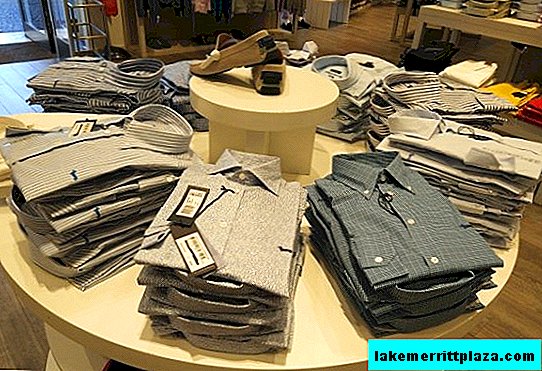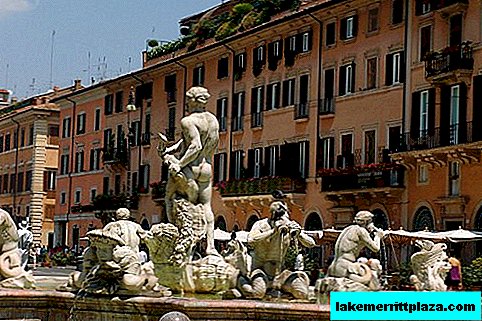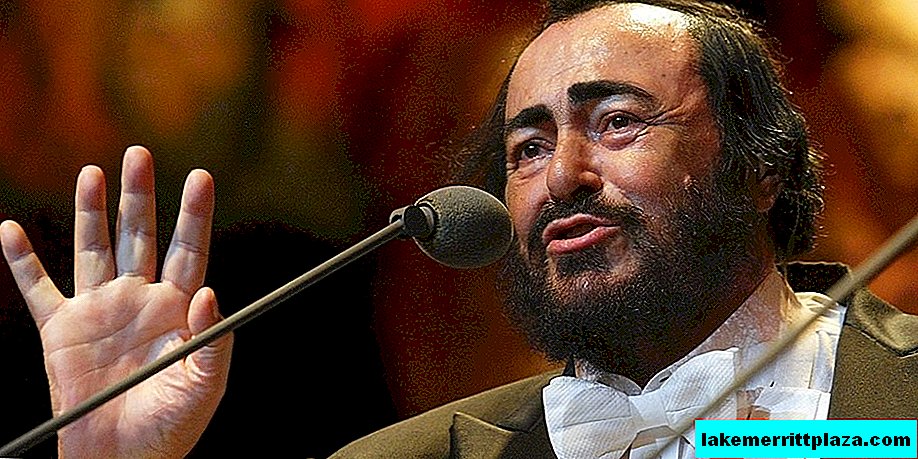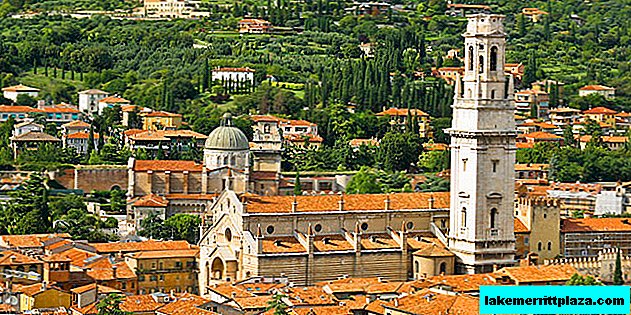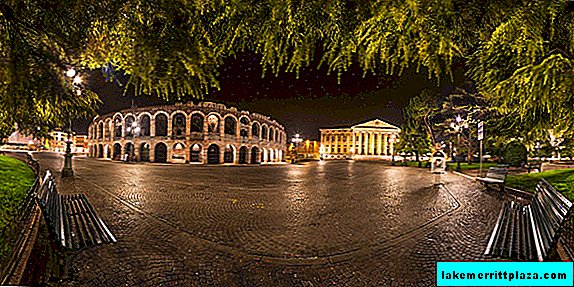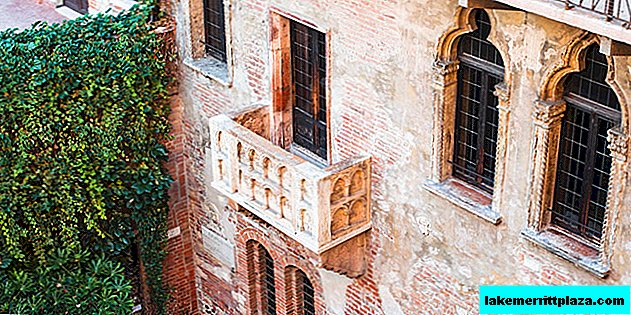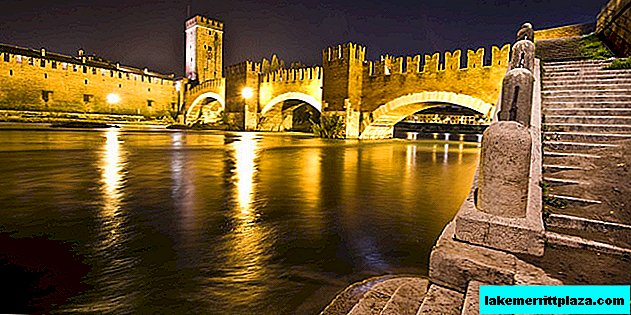Bologna has a special harmony: cozy small squares, narrow alleys, terracotta houses with red roofs give the city a unique flavor. A striking sign - arched gallery passages.

Bologna (photo by Rob Oo
Bologna (Bologna) is called "scientist, red, well-fed." “Scientist” because the city has the oldest university in Europe; “Red” because the houses are built of red bricks and the tiled roofs are red; “Full or rich,” because residents love to eat and do not deny themselves this pleasure. Bologna is a developed industrial city, one of the richest in Italy - the capital of Emilia-Romagna. Life is in full swing on the old streets: the city is full of tourists and students, a series of musical events and gastronomic festivals take place here. Yes, these are not just streets, but covered galleries, which total 36 km.
What you need to do in Bologna
- Climb to the Asinelli tower, admire the "terracotta" city from a height.
- See the "seven churches" of the monastery complex of Santo Stefano.
- Take a walk under the roofs in the open air - go around the 36-kilometer chain of Bologna indoor galleries.
- Buy a unique puppet doll by Demetrio Prensini in a workshop on Vittorio Veneto.
- Visit Bologna trattorias, evaluate local culinary achievements - lasagna, stew-bolognese, tagliatelle, the legendary tortellini.
When is the best time to go?
Bologna is located on the edge of the fertile Padan Lowlands near the Northern Apennines. It has a humid subtropical climate with rainy off-season and rare, but heavy winter snowfalls. The average summer temperature is approximately + 23 ° C; in winter - about + 2 ° C.
It’s better to go to Bologna in the spring: it’s not very hot yet, and the influx of tourists is less. But if you decide to visit here in the winter, then stock up on warm waterproof clothes and shoes; the weather will be dank due to high humidity. But in August it is better not to go to Bologna: heat, vegetation is scarce, there is no river, no sea. The Italians have a vacation period.
What to look for
Bologna is famous for its towers, narrow streets with arcades and canals.
Towers
Once in the city, almost 100 towers were erected. They were not only defensive structures, but also indicators of their condition - the richer the family, the higher the tower. Today, many of them have not been preserved or dismantled. All about the towers can be found in the Museum of the History of Bologna (Museo della Storia di Bologna).
Arcade
In Bologna, it was not allowed to build outside the walls, so it was necessary to build up the upper floors above the roadway, but taking into account that the rider could pass. The hanging floors were propped up in columns. The streets became narrow. Today, arcades stretch along almost every house in the historic center of Bologna, form long corridors that are not afraid to walk in the rain.
Channels

A piece of Venice in Bologna, photo Twice25
In the Middle Ages, the canal network in Bologna was one of the most extensive in Italy. Now almost all of them are bombarded. But if you turn off from Independence Street to 18 Pella Street, you will see a “piece of Venice”, one of the few surviving canals.
Sights
 Gates with the tower of San Vitale
Gates with the tower of San Vitale
 Il gelatauro
Il gelatauro
 Gates of San Vitale
Gates of San Vitale
 San Donato Gate
San Donato Gate
 Luigi Cattaneo Anatomical Wax Museum
Luigi Cattaneo Anatomical Wax Museum
 University
University
 Pinacoteca
Pinacoteca
 Poggi Palace
Poggi Palace
 San Giacomo Maggiore
San Giacomo Maggiore
 Restaurant Osteria dellOrsa
Restaurant Osteria dellOrsa
 Old Jewish Ghetto
Old Jewish Ghetto
 Garisenda and Asinelli Towers
Garisenda and Asinelli Towers
 Ice cream parlor
Ice cream parlor
 Pizzeria Two Towers
Pizzeria Two Towers
 Church of Saints Bartholomew and Cayetan
Church of Saints Bartholomew and Cayetan
 Santo Stefano
Santo Stefano
 Basilica of St. Dominic
Basilica of St. Dominic
 Galvani Square
Galvani Square
 Archimnasium
Archimnasium
 Anatomical theater
Anatomical theater
 Archaeological Museum
Archaeological Museum
 Palace of Banks
Palace of Banks
 Pizzeria Rossopomodoro
Pizzeria Rossopomodoro
 Basilica of San Petronio
Basilica of San Petronio
 Palace of Notaries
Palace of Notaries
 Palazzo D'Accursio
Palazzo D'Accursio
 Communal Palace
Communal Palace
 Exchange Hall
Exchange Hall
 Neptune Fountain
Neptune Fountain
 Palace of Podesta
Palace of Podesta
 Palace of Re Enzo
Palace of Re Enzo
 Basilica of San Francesco
Basilica of San Francesco
 Saint Paul's Cathedral
Saint Paul's Cathedral
 Independence Street
Independence Street
 Montagnola Park
Montagnola Park
 Square September 20
Square September 20
 Bologna Central Station
Bologna Central Station
City gate

Gateway to the San Vitale Tower (Torresotto di San Vitale), photo by Walter MelTay

Gates of San Vitale (Porta San Vitale), photo by Paolo Bonassin
In the Middle Ages, Bologna was surrounded by a brick wall, which was built three times as the city expanded. Her remains can be seen today. Also survived 8 of the 12 city gates. Therefore, it is logical to start our walk in Bologna from the gate with the tower of San Vitale (Torresotto di San Vitale) (XII century). Via S. Vitale will lead to other gates - Porta San Vitale (13th century).
On the way, drop by Il Gelatauro (Via S. Vitale, 98) and try delicious ice cream or a cup of coffee with Sicilian cannoli and buy homemade chocolate.

Gate of San Donato (Porta San Donato), photo by Simone Pietrelli
If you walk along the city walls along Strada statale 9 (SS9), then after 500 m you will see the gates of San Donato (Porta San Donato) (XIII century).
Luigi Cattaneo Anatomical Wax Museum

Luigi Cattaneo Wax Museum (Museo delle Cere anatomiche "Luigi Cattaneo"), photo by Gardner Muirhead
The anatomical wax museum of Luigi Cattaneo (Museo delle Cere anatomiche "Luigi Cattaneo") is a collection of wax manuals that demonstrates the anatomy of a normal person and with pathologies. Students in the XVIII-XIX centuries from these exhibits studied the true nature of the human body.
University

University, Faculty of Law, photo sailko
We cross Via Irnerio and find ourselves in the student quarter. The University of Bologna (Università di Bologna) is not one building, but 23 faculties, 68 departments, where 87 thousand students from all over the world study. The higher education institution, opened since 1088, has never stopped its work and is considered the oldest in Europe. Copernicus, Galvani, Petrarch and Dante, Paracelsus, Carlo Goldoni and Albrecht Durer, Torquato Tasso, Marconi studied here.
Pinacoteca

National Pinacoteca (Pinacoteca Nazionale), photo by Mattes
The National Pinacoteca of Bologna (Pinacoteca Nazionale) has been open since 1875 in the former building of the Order of St. Ignatius. The beginning of the collection was a collection of paintings by the Bologna school of painting of the XIII-XVIII centuries. Later, icons, altar paintings and other values from closed churches and monasteries were added.
Here you will see: “The Crucifixion” by Giovanni da Modena and “The Crucifixion” by Rinaldo di Ranuccio, “Our Lady of Glory with the Saints” Pietro Perugino and “Our Lady with the Baby” by Giotto, “Ecstasy of St. Kikilia” by Raphael, “St. George and the Dragon” by Vitale da Bologna. The Renaissance is represented by the works of such masters as Lorenzo Costa, Francesco del Cossa, Amiko Aspertini, Francesco Franchi, Bartolomeo and Antonio Vivarini, Ercole de Roberti ,.
Poggi Palace

Palazzo Poggi Palace, photo by George Milligan
In the Palazzo Poggi (built in 1549-1560) there are a university administration, a university library, the Museum of the Palace of Poggi (Museo di palazzo Poggi), the Museum of the Observatory (Museo della Specola) and the European Student Museum (Museo Europeo degli Studenti).
The palace building is two-story, the inner square courtyard is framed by galleries, the main staircase leads to the upper floor. On the 1st floor is the Hercules Hall and an auditorium where he taught Italian language and literature Carducci, poet and Nobel Prize winner.
The Museum of the Palazzo Poggi (Museo di palazzo Poggi) is an exhibition of scientific achievements of the University of Bologna. The exhibition presents a variety of scientific objects: wax parts of man; visual materials on the pathology of pregnancy; models of ships and fortifications, the first geographical maps. On the walls of the halls are frescoes by Fontana, Tybaldi, Procaccini. There are collections of botanical and zoological exhibits by Ulysses Aldrovandi, Kunstkamera Marquis Ferdinando Cospi.
The exposition of the European Museum of Studentship is dedicated to the everyday life of students of the past, the movement of vagantas and the hollywood.
San Giacomo Maggiore

San Giacomo Maggiore (Basilica di San Giacomo Maggiore), photo by Paul Hermans
The Basilica of San Giacomo Maggiore (Basilica di San Giacomo Maggiore) and the monastery were founded by the Augustinians in 1267. In the XVIII century, the monastery was closed, and the city conservatory opened in its walls. Today, the church, courtyards, main staircase, library and dining room have been preserved from the monastery.
San Giacomo Maggiore is a one-nave basilica with 35 chapels. The architecture traces the transition from the Romanesque to the Gothic. In 1336, the bell tower was added. In the XVI century, a large-scale reconstruction was carried out. Renowned masters such as Francesco Francha, Lorenzo Costa, Amiko Aspertini, designed the church.
Hungry? Restaurant Osteria dell'Orsa (Via Mentana, 1) is suitable for lunch and tasting dishes of traditional Emilian cuisine, and the prices are moderate. The food is almost homemade and the wine is excellent.
Old Jewish Ghetto

Judeev Street (Via De 'Giudei), photo cinziamalaguti.it
The former Jewish ghetto is one of the most interesting and vibrant corners of the city with labyrinths of streets, small windows, covered bridges and suspension crossings. The ghetto area was fenced with 2 bars: one was at the beginning of via de 'Giudei, the other was on via Oberdan, where now there is an arch that faces Mandria Lane. The main artery of the Jewish quarter was Hell Street (Via dell'Inferno), here bankers, merchants and junk workers (the only possible professions for Jews) were engaged in their craft. Small streets and alleys flocked to it: via Canonica, via de 'Giudei, via Valdonica, vicolo Mandria, vicolo di S. Giobbe, via del Carro.
The old ghetto is an ideal place for relaxing walks. Walk along Judeev Street (via de 'Giudei), to Piazza di Porta Ravegnana Square.
Two towers

Garisenda and Asinelli Towers (Torri Garisenda e Asinelli), photo by Sergio Andrés Madera
Once upon a time, over a hundred towers towered over the city; each rich family simply had to have its own tower, and the higher the better. Today only 24 are left, two of them are “falling”. The top of the 97-meter-high Asinelli (Torre degli Asinelli) is deviated from the vertical axis by 2.23 m. The structure is made of rough brick; 498 wooden steps lead to the upper viewing platform; ticket costs € 5.
Asinelli's “neighbor”, the 48-meter-long Garisenda (Torre della Garisenda), was much taller during construction, but due to the strong slope it was partially demolished to avoid collapse. Both towers were founded in the 11th century.
Today, the Two Towers is a symbol of Bologna, under them the townspeople make appointments.
At Gelateria Gianni Cafe (Via S. Vitale, 2), enjoy amazing Italian ice cream. And in the small Trattoria Pizzeria Due Torri (Via Riva di Reno 1) - the best pizza in Bologna.
Church of Saints Bartholomew and Cayetan

Church of Saints Bartholomew and Cayetan (Chiesa dei Santi Bartolomeo e Gaetano), photo attilio47
The church was first mentioned in 1288: a community of nuns of Cluny erected a church in honor of St. Bartholomew on the foundation of an early Christian church. In 1599, the building was transferred to the male order of the theater. The structure was reconstructed. In 1671, the founder of the Order of St. Caetan was canonized. The temple began to be called - Church of Saints Bartholomew and Cayetan (Chiesa dei Santi Bartolomeo e Gaetano). The interior is decorated with ionic columns, the space is filled with light pouring from the windows. Formigine gallery lunettes are painted with scenes from the life of St. Caetana. The temple is decorated with frescoes in the style of "illusionism" and paintings by Italian masters.
Santo Stefano

Santo Stefano (Basilica di Santo Stefano), photo by AHert
The Santo Stefano complex (Basilica di Santo Stefano) is called the site of the "Seven Churches" (Le sette Chiese). This is the Church of the Holy Sepulcher, "transferred" to St. Petronio from Jerusalem to Bologna land. At the beginning there were 7 churches, today there are 4 left - the basilica of St. Martyrs Vitaly and Agricola (4th century), Church of the Holy Sepulcher (5th century), Church of John the Baptist or Crucifixion of the Lord (8th century), Church of the Holy Trinity (13th century). They were erected on the foundation of the ancient temple of Isis. The monastery courtyard with a well is one of the best examples of the Romanesque style, you can get here through the arched gallery from the Trinity Church.
A flea market operates on Santo Stefano Square every second weekend of the month.
Basilica of St. Dominic

Basilica of San Domenico (Basilica di San Domenico), photo by Paolo Dell'Angelo
On the square in front of the Basilica di San Domenico (XIII century) there are 2 “arches” - the tombs of glossators (medieval lawyers, Roman law teachers) Rolandino de Passageri and Egidio Foskerari.
The basilica itself is one of the important temples of Bologna, an architectural model for Dominican churches around the world. Inside is a sarcophagus made of marble, where the remains of St. Dominic, founder of the Dominican Order. The creation of the tomb and the decoration of the temple was attended by the young Michelangelo. The basilica in the XX century received a new facade. Outside, the building is modest, but inside - beauty and grandeur. The temple is light and usually deserted. The church has 2 bodies. Mozart himself played on one when he studied in Bologna.
Galvani Square

Piazza Galvani, photo by Marco Assini
Piazza Galvani is the square at the back of the Basilica of San Petronio. In the center of it opposite the old university building is a monument to Galvani, the father of modern electrophysiology. The famous physiologist was born in Bologna, graduated from the theological and medical faculties of the university, and then headed the department of anatomy and gynecology.
Archimnasium

Archigymnasium (Archiginnasio), Assembly Hall; photo poprostuflaga
Archigymnasium (Archiginnasio) was built in 1563. Until 1803, it was the main building of the University of Bologna and was called Studium. It united the scattered faculties of the university within its walls.
The main decoration of the building is coats of arms, commemorative inscriptions, emblems of eminent teachers and students on the walls and arches. The courtyard, framed by porticoes, is built around the former Bulgarian Virgin Church. Upstairs were classrooms.
The Anatomical Theater and the Assembly Hall are located on the 2nd floor. In 1838, a part of the building of the Archgymnasium was allocated for the municipal library.
Anatomical theater

Anatomical Theater (Teatro Anatomico), photo by Oliver Verheij
The hall of the Anatomical Theater (Teatro Anatomico) is covered with elaborate wooden decoration and decorated with statues and busts of famous doctors. 2 central male sculptures are presented without skin, probably, these are training aids on groups of human muscles. The ancient marble prozector table has been preserved.
Assembly Hall
In the Assembly Hall of the Archgymnasium there are also many emblems. Bookcases stretch along the walls. Here was first performed "Stabat mater", a work by Rossini. In honor of this event, the hall was named Stabat mater.
Archaeological Museum

Archaeological Museum (Museo civico archeologico), photo by ZiKiarts
The Bologna City Archaeological Museum (Museo civico archeologico) was opened in 1881 in the Palazzo Galvani Palace. At its exhibitions exhibits of the Iron Age, Ancient Egypt and Rome are presented.
Maggiore Square

Piazza Maggiore, photo by J. Mario Franco
We go to Piazza Maggiore, which flows smoothly into Piazza Re Enzo and Nettuno. The medieval Piazza Maggiore (Piazza Maggiore - Large Square) is called the "heart of Bologna". In the XIII century, it was an urban market. Now all the main events of the city’s life are taking place here.
Palace of Banks

Palace of Banks (Palazzo dei Banchi), photo Fotostream DE
The Palace of Banks (Palazzo dei Banchi) was erected for the needs of city banks in the XV-XVI centuries. On the south side is Portico Pavaglione, a famous stroll of the Bologna beau monde in the 19th century.
Are you tired? Real Italian pizza will help restore strength - hearty, tasty, budget. Pizzeria Rossopomodoro on Via Clavature, 12.
Basilica of San Petronio

Basilica of San Petronio (Basilica di San Petronio), photo by raffaele pagani
The Piazza Maggiore is dominated by a grand 14th-century basilica - San Petronio (Basilica di San Petronio) (its construction has not yet been completed), with a museum of sacred art and a panoramic rooftop terrace. The walls of the cathedral are faced with marble exactly half, the light lower tier contrasts with the gloomy brick dome. 11 chapels of the cathedral are decorated with frescoes, polychrome stained-glass windows, paintings and sculptures. Pay attention to the unique fresco of the XV century. the work of Giovanni of Modena with a scene from Dante - the Prophet Muhammad plunged into hell. 66.8 m long "Giovanni Cassini" meridian runs across the floor. The relics of Bologna’s heavenly patron Saint Saint Petronius are stored in San Petronio. In 1530, Charles V was crowned in the basilica as emperor of the Holy Roman Empire.
Palace of Notaries

Palace of Notaries (Palazzo dei Notai), photo by Nikolay Lozanov
The Notaries Palace (Palazzo dei Notai) was built for the Notaries Society in 1384-1422.
Palace of the Commune

Palazzo D'Accursio or Palace of the Communal, photo by Massimo Battesini
The Palace of the Commune (palazzo Comunale - Commune) consists of several buildings built at different times and connected in a single rectangular shape. New buildings have been attached to the residence of the lawyer D'Accursio (palazzo D'Accursio) of the 13th century for centuries. Since 1336, Antsiani (elders) met here, then the main masters of the commune, and later the government.And the palace received a new name - the palace of the Communal. In the XV century, a clock tower was attached to it. Today the building belongs to the city administration.
On the 1st floor of the Palazzo Comunale, there is a city council meeting room; on the 2nd - Farnese Hall, where Charles V was crowned Charles V in 1530, and the Legato Chapel. On the 3rd - City Art Museum with works by masters of the XIII-XIX centuries. Until 2012, the Giorgio Morandi Museum was working in the palace, now it has been transferred to the Museum of Modern Art.

Sala Borsa, photo by Lorenzo Gaudenzi
Part of the palace complex is the Exchange Hall (Sala Borsa - Salabors). This is a covered square where the municipal multimedia library operates today. During the construction of the Exchange, ancient foundations were opened, which can now be viewed through glass floors.
Neptune Square
We pass to the Piazza Nettuno (Piazza del Nettuno), where the Neptune Fountain and 2 palaces - Podesta and Re Enzo.
Neptune Fountain

Neptune Fountain, photo Melisenda2010
The colorful fountain Neptune is the work of the sculptor Dzhambolony (1567). Locals call it - Giant. In the middle of the building - a three-meter nude figure of the God of the seas - a symbol of the reign of Pius IV. Water came to the fountain from the purest spring of Remond, it was strictly forbidden to pollute it.
The Italian automobile company Maserati was founded in Bologna in 1914, and the fragment of the trident of Neptune took the emblem.
Palace of Podesta

Palazzo Podestà (Palazzo del Podestà), photo by Sara Saviozzi
Palazzo Podesta (palazzo del Podestà - Palace of Rulers) or the Old Palace was erected in the 13th century for the mayor or Podestà. In the XV century, it was rebuilt in the Renaissance style by the Italian architect Aristotle Fioravanti, who built the Assumption Cathedral in the Moscow Kremlin.
Palace of Re Enzo

Palazzo Re Enzo (palazzo di Re Enzo), photo by Juanfran
The Palazzo Re Enzo (palazzo di Re Enzo) was created to expand the Palazzo Podesta, and therefore was to be called New. But in 1249, the king of Sardinia, Enzo, was imprisoned here and the palace was renamed.
If you stand at the intersection of through galleries in one of the 4 corners of the Podest palace and whisper something, then you will be heard in the opposite corner at a distance of 5 m.
Basilica of St. Francis

Basilica of San Francesco (Basilica di San Francesco), photo by Zaki Ameen
The Basilica of San Francesco (Basilica di San Francesco) was built in the 13th century and was part of the monastery complex. This is the first church in Italy, built in the characteristic style of French Gothic: lancet windows and arcbutans above the chapels. The austere facade in the Romanesque-Gothic style looks majestic. There is little painting in the interior, mostly sculpture. The main altar is decorated with Gothic marble polyptych of the XIV century, dedicated to St. Francis.
In front of the Basilica there are arches where famous glossators are buried.
Saint Paul's Cathedral

St. Peter's Basilica (Cattedrale di San Pietro), photo rrm998
St. Peter's Cathedral (Cattedrale di San Pietro) was built on the site of an early Romanesque temple of the 10th century. It was rebuilt several times, so the Romanesque and Gothic features were lost. The main reconstruction took place in the XVI-XVII centuries. Today, the exterior and interior are decorated in the Baroque style. The facade is decorated with statues of Saints Peter and Paul. The interior has preserved medieval frescoes and sculptures. Noteworthy is the sculptural group Alfonso Lombardi "Mourning the departed Christ" and a crucifix on the main altar. A museum is opened in the temple, where religious utensils presented from the 15th to the 20th century are presented. Since the 16th century, a special Bologna bell ringing has been heard from the belfry of the cathedral.
Independence Street

Independence Street (Via dell'Indipendenza), photo by ZiKiarts
From Piazza Maggiore to the central station, Independence Street (Via dell'Indipendenza), the city’s most popular and lively street, runs through the passageways of the galleries. Here are concentrated restaurants, coffee houses, many shops.
Montagnola Park

Montagnola Gardens (Giardino della Montagnola), photo by Sailko
Park "Montagnola Gardens" (Giardino della Montagnola) - the oldest park in Bologna, a favorite vacation spot. It was laid in the XVII century on the artificially created Montagnola hill. At the entrance from Independence Street, there is a monument to the People, which is dedicated to those who died on August 18, 1848.
Square September 20

September 20 Square (Piazza XX Settembre), photo spacetrash
In the center of the square on September 20 (Piazza XX Settembre) the gates of Porta Galliera rise. Here you will also see the ruins of a castle built for Pope John XXII.
Central station

Bologna Central Station (Stazione di Bologna Centrale), photo by Bill Johnston
Bologna Central Station (Stazione di Bologna Centrale) was opened in 1864. From the station, the tour bus route begins in the historic center.
A bit of history
The territory of modern Bologna was inhabited by the 10th century BC. The first fortified city was founded by the Etruscans, calling it Velzna - Felsina. The Romans owned the territory from 189 BC. The rich Roman settlement of Bononia during the heyday of the great Empire was the fifth in Europe in terms of population. Since the VIII century, Bologna received the status of a free city from Charles the Great, in the XII-XVI centuries it was tormented by fierce internecine wars, devastated the plague. Since 1506, it belonged to the papal throne - for a short period it was occupied by Napoleon, but returned under the influence of Rome. Since 1860 it became part of the kingdom of Sardinia - the predecessor state of Italy.
Fun and Holidays

Sotto le stelle del Cinema Film Festival, photo by Rino Fazzini
Christmas in Bologna is a relaxing family holiday. Locals do not go to visit, do not invite friends. The streets are quiet, entertainment venues close on December 24th. The New Year, on the contrary, is a noisy and cheerful celebration: mass celebrations and parties take place, fireworks sound, champagne is opened on the streets.
Every year at the end of January, Bologna holds the international art fair ArteFiera, dedicated to contemporary world art.
In April, the Future Film Festival is held - an international film festival dedicated to animated films and new technologies.
In the middle of summer, a film festival is held dedicated to the opening of rare and little-known films - Il Cinema Ritrovato, with free screenings in open areas.
October-November - the time of the festival of jazz music - Bologna Jazz Festival.
In mid-October, the festival "Queen of Sausages" - Mortadella (MortadellaBO ').
In November, stands of the Chocolate Fair, Cioccoshow di Bologna, are being set up in Marjoré and Galvani squares.
What dishes to try in Bologna

Tagliatelle with Bolognese sauce, photo agrodolce.it
Bologna has an infinite number of restaurants and cafes, enotec and wine bars. The price tags are also different.
If you order spaghetti bolognese in Bologna, you will be disappointed. There is no such dish here. There is stew alla bolognese, which is served exclusively with tagliatelle egg noodles (tagliatelle al ragù alla bolognese - tagliatelle with bolognese sauce). Stop by, for example, A Balus (Via del Borgo di San Pietro 9 / 2A), an Italian restaurant.
Beef chop (Cotoletta alla bolognese) of veal is one of the oldest and most hearty dishes. Who likes to experiment, try horsemeat or donkey dishes.
Local restaurants make delicious lasagna. Taste rice cake (Torta di riso) from rice, almonds, sugar, eggs with lemon zest; piadina (piadina) - Romagnolsky cake with filling.
In the restaurants of Casa Monica, Trattoria dal Biassanot, Da Vito I Matti Della Polenta, you can inexpensively enjoy traditional Italian cuisine, simple and hearty.
Banco 32 (Via S. Gervasio, 3 / A) - An excellent fish restaurant in the market with fresh seafood and its own unique atmosphere.
What's around
Madonna di San Luca

Madonna di San Luca, photo by Jennifer
At a distance of 3.5 km from Bologna, on Guard Hill, stands the pilgrimage temple Madonna di San Luca. Believers strive there to see the precious icon of the Virgin, painted, according to legend, by St. Luke himself. From the gates of Zaragozza to the Catholic sanctuary, the longest covered arched gallery of 666 porticoes with fifteen chapels stretches along the hills and plains.
Full Day Routes
Bologna is an important transport hub, so it is convenient to make day trips from here. In 1.5 hours you can drive to Florence, Venice, Milan, Verona, and in 2 hours - to Rome, Vicenza, Mantua. Of course, it is impossible to inspect these cities in a day, but you will get a general impression. It is convenient to travel by train (www.trenitalia.com and www.italotreno.it) or on a rented car (see a rental car here.).
Small towns near Bologna

Ferrara (Ferrara), photo Marco Delvecchio
The town of Imola is located on the Santerno River, 40 kilometers from the center of Bologna. Next to it is the track "Formula 1". The historic center crosses the ancient Roman path Via Emilia. The castle of the XIV century - Rocca di Sforza Imola has been preserved here.
Modena (45 km) is a small town. Its main attractions are the cathedral and Modena vinegar. In Modena, the founder of the automobile company and the auto racing team Enzo Ferrari was born.
If you are interested in Ferrari cars, then go to Maranello, where the production, the headquarters of the company and the Formula 1 team "Scuderia Ferrari" are located.
Ferrara (50 km) for some reason is not popular with tourists. Sights of the city: Duomo, Castello Estense, Palazzo dei Diamanti, etc.
The 19th-century Rocchetta Mattei castle (60 km) is similar to the Moorish palace and the Orthodox church at the same time. It looks impressive. An excursion to it must be booked in advance.
An hour's drive southeast of Bologna is Faenza, the world “capital” of faience. Since the 15th century, it has become a center for the production of majolica and ceramic products. Bright monuments of the Renaissance and Classicism periods have been preserved here; The International Museum of Ceramics was opened.
Ravenna (95 km) - one of the most interesting cities in Emilia-Romagna. She was not long the capital of the Roman Empire. The main attraction is the early Christian churches and their mosaics.
Parma (100 km) is known for its delicacies - cheese and ham. Sightseeing: Basilica of Santa Maria della Stekkata, Cathedral, Baptistery, Teatro Farnese and Palazzo della Pillota, Ducal Palace with a park.
Rimini (117 km) is a pretty city. It preserved the ancient Roman arch of Augustus.
Padova (160 km) is already the Veneto region. Look at the Scrovegni chapel with frescoes by Giotto, palaces, squares.
In Urbino (176 km) Rafael was born. The ruler and duke of the city of Federico de Montefeltro built not only a stunningly harmonious city, but supported artists and poets.
How do I save on hotels?
Everything is very simple - look not only at the booking. I prefer the search engine RoomGuru. He is looking for discounts at the same time on Booking and on 70 other booking sites.


